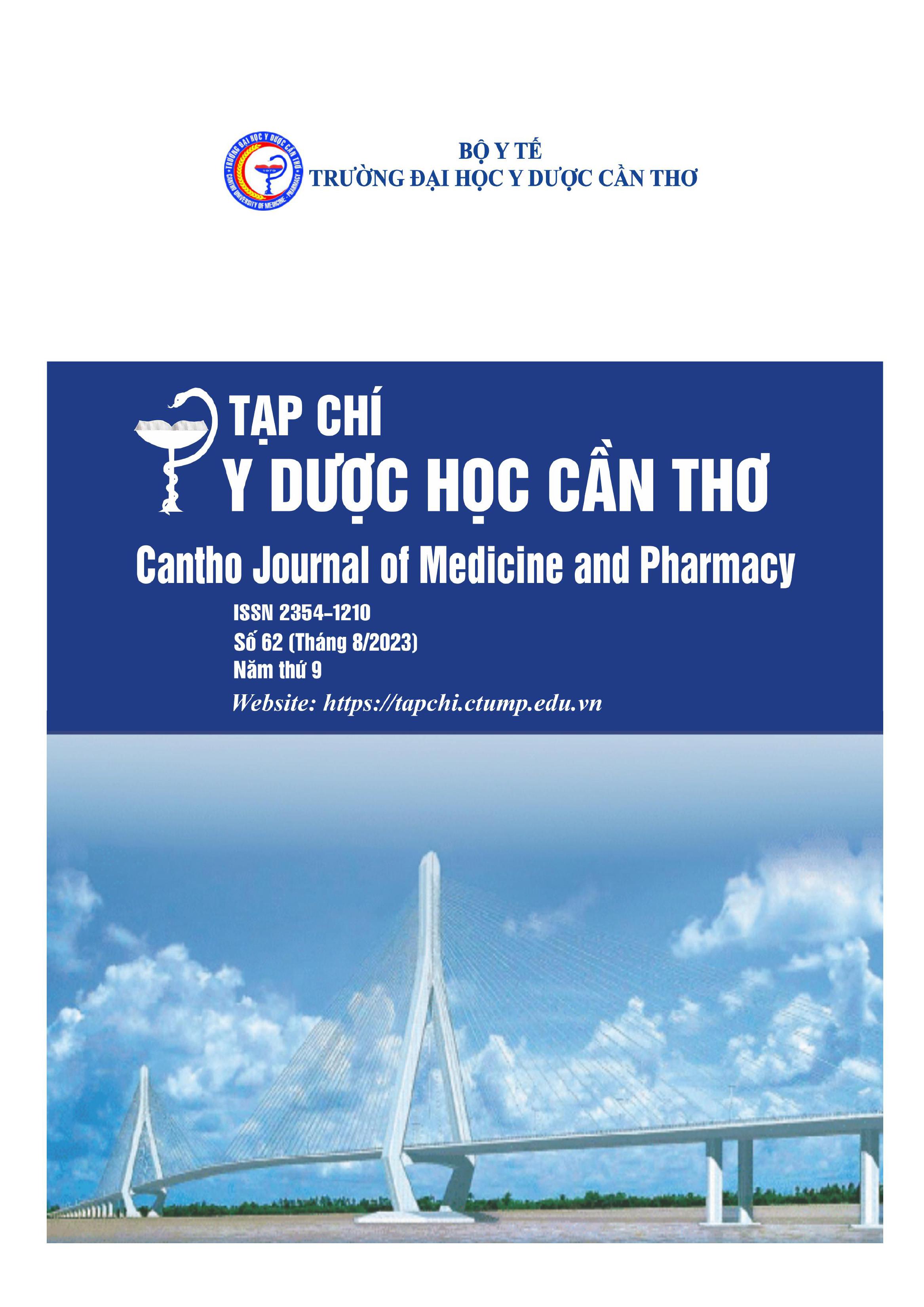THE USE OF PROPHYLACTIC ANTIBIOTIC FOR PATIENTS CESAREAN SECTION AT A HOSPITAL IN SOC TRANG IN 2022
Main Article Content
Abstract
Background: Many recent studies have shown that the rational use of prophylactic antibiotics reduces the mortality rate, reduces the rate of antibiotic resistance and saves costs for patients. Objectives: To analyse the situations of using antibiotics in cesarean section patients at a hospital in Soc Trang province in 2022. Materials and methods: A cross-sectional descriptive study with 345 caesarean section patients was randomly selected from July 1, 2022 to September 30, 2022. Analysis of the characteristics of prophylactic antibiotic use and factors related to the using of rational prophylactic antibiotics. Results: The old incision was the most common reason indicated for cesarean section (47%), the rate of surgical site infection was low (1.2%). All medical records have used prophylactic antibiotics (100%). The most commonly used antibiotic was Amoxicillin and clavulanic acid (89%). The rate of medical records with inappropriate selection of prophylactic antibiotics was (10.4%), dose of antibiotic unreasonable was (11%). Patients <18 years old may have a lower rate of reasonable antibiotic selection and reasonable antibiotic dose than other groups of patients (OR < 1 and p < 0.05). Conclusions: Amoxicillin + clavulanic acid was the most commonly used antibiotic in the study. The cause of the inappropriate use of antibiotics may be due to the choice of antibiotics and the inappropriate dose of antibiotics. Patients < 18 years old may be risk factors for reducing the rate of rational antibiotic prophylaxis in hospital cesarean section.
Article Details
Keywords
Rational, prophylactic antibiotics, cesarean section, Soc Trang
References
2. Claudia Bollig, et al. Prophylactic antibiotics before cord clamping in cesarean delivery: a systematic review. Acta Obstet Gynecol Scand. 2018. 97(5), 521-535, https://doi.org/10.1111/aogs.13276.
3. Bộ Y tế. Hướng dẫn sử dụng kháng sinh. Nhà xuất bản Y học, Hà Nội. 2015.
4. Nguyễn Văn Mạnh. Phân tích sử dụng kháng sinh trên bệnh nhân phẫu thuật tại bệnh viện Đa khoa Phố nối. Đại học Dược Hà Nội. 2018. 45-52.
5. Nguyễn Văn Dương. Phân tích tình hình sử dụng kháng sinh trên bệnh nhân bệnh nhân phẫu thuật mổ lấy thai tại Khoa Sản Bệnh viện Đa khoa tỉnh Quảng Ninh. Đại học Dược Hà Nội. 2019. 35-40.
6. Hoàng Thị Thu Hương. Triển khai chương trình kháng sinh dự phòng trong mổ lấy thai tại Bệnh viện Đa khoa Trung ương Thái Nguyên. Đại học Dược Hà Nội. 2019. 38-39.
7. Alshehhi H.S., Ali A. A., Jawhar D. S., et al. Assessment of implementation of antibiotic stewardship program in surgical prophylaxis at a secondary care hospital in Ras Al Khaimah. United Arab Emirates. 2021. 11(1), 1042, https://doi.org/10.1038/s41598-020-80219-y.
8. Huang Y., Yin X., Wang X., et al. Is a single dose of commonly used antibiotics effective in preventing maternal infection after cesarean section? A network meta-analysis. PLoS One. 2022. 17(4), e0264438, https://doi.org/10.1371/journal.pone.0264438.
9. Trần Thị Hương Ngát. Phân tích tình hình sử dụng kháng sinh trên bệnh nhân phẫu thuật mổ lấy thai tại Khoa Sản Bệnh viện Đa khoa Khu Vực Cẩm Phả. Đại học Dược Hà Nội. 2019. 42.
10. Phạm Thị Kim Huệ, Đặng Nguyễn Đoan Trang. Khảo sát việc sử dụng kháng sinh dự phòng trong phẫu thuật sạch, sạch nhiễm tại bệnh viện Đại học Y Dược Thành phố Hồ Chí Minh. Y Học Thành phố Hồ Chí Minh. 2018. 22(1), 83-88.
11. National Institute for Health and Care Exellen. Surgical site infections: prevention and treatment. NICE guideline [NG125]. 2020. 8-11. https://www.nice.org.uk/guidance/ng125.
12. Nguyễn Hữu Thâm. Đánh giá biến chứng phẫu thuật mổ lấy thai theo thang điểm CLA VIENDINDO tại Bệnh viện Đa khoa khu vưc Ngọc Hồi. Công trình nghiên cứu khoa học Bệnh viện Ngọc Hồi, tỉnh Kon Tum. 2016. 34-35.
13. Bratzler D. W., E. P. Dellinger, K. M. Olsen, et. al. Clinical practice guidelines for antimicrobial prophylaxis in surgery. Am J Health Syst Pharm. 2013. 70(3), 195-283, https://doi.org/10.2146/ajhp120568.
14. Committee on Practice Bulletins-Obstetrics. ACOG Practice Bulletin No. 199: Use of Prophylactic Antibiotics in Labor and Delivery. Obstet Gynecol. 2018. 132(3), 103-119, https://doi.org/10.1097/AOG.0000000000002833.
15. World Health Organization. Global guidelines for the prevention of surgical site infection, 2nd ed. WHO Document Production Services, Geneva, Switzerland. 2018. 58-76. https://apps.who.int/iris/handle/10665/277399.


